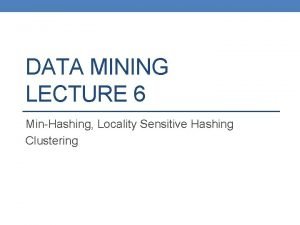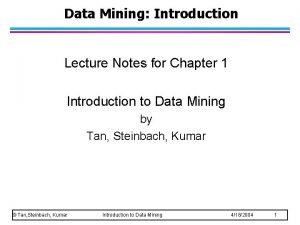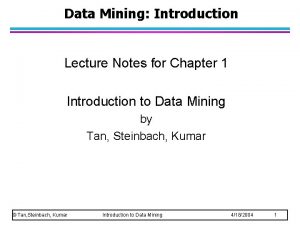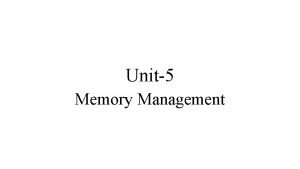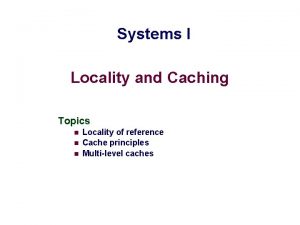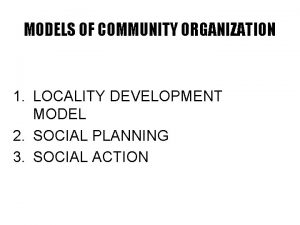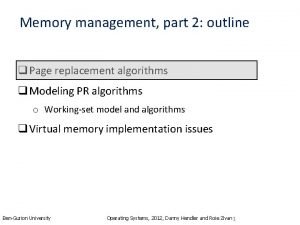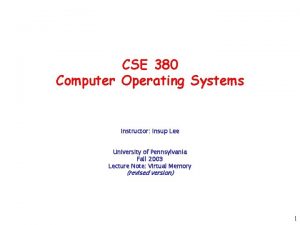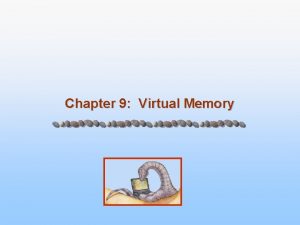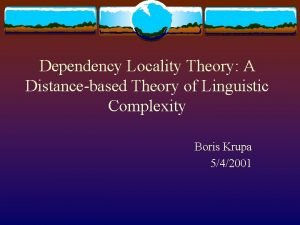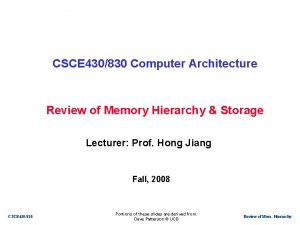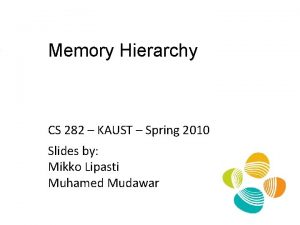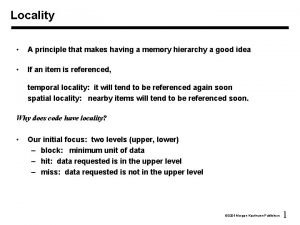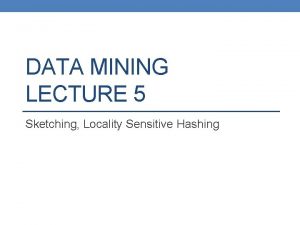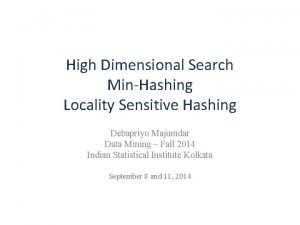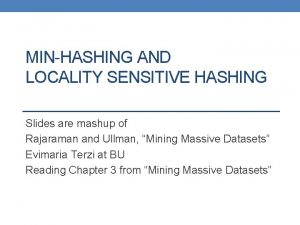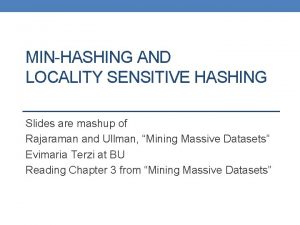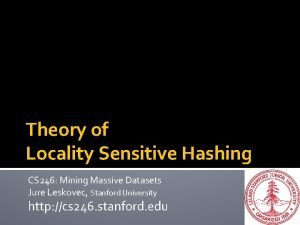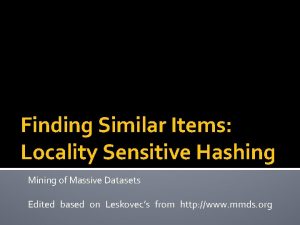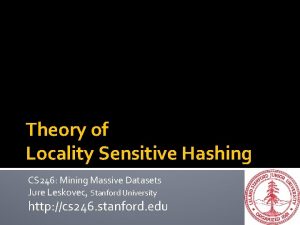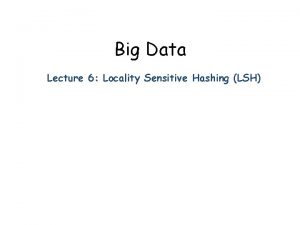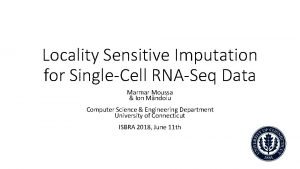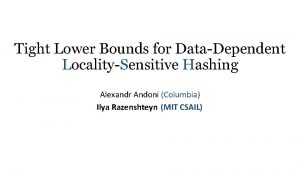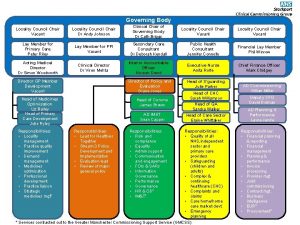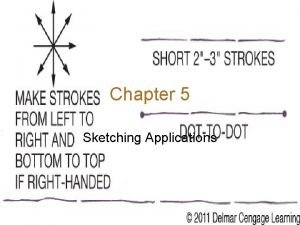DATA MINING LECTURE 6 Sketching MinHashing Locality Sensitive



















































- Slides: 51

DATA MINING LECTURE 6 Sketching, Min-Hashing, Locality Sensitive Hashing

MIN-HASHING AND LOCALITY SENSITIVE HASHING Thanks to: Rajaraman, Ullman, Lekovec “Mining Massive Datasets” Evimaria Terzi, slides for Data Mining Course.

Motivating problem • Find duplicate and near-duplicate documents from a web crawl. • If we wanted exact duplicates we could do this by hashing • We will see how to adapt this technique for near duplicate documents

Main issues • What is the right representation of the document when we check for similarity? • E. g. , representing a document as a set of characters will not do (why? ) • When we have billions of documents, keeping the full text in memory is not an option. • We need to find a shorter representation • How do we do pairwise comparisons of billions of documents? • If exact match was the issue it would be ok, can we replicate this idea?

5 The Big Picture Document Shingling Minhashing The set of strings of length k that appear in the document Signatures : short integer vectors that represent the sets, and reflect their similarity Localitysensitive Hashing Candidate pairs : those pairs of signatures that we need to test for similarity.

Shingling • Shingle: a sequence of k contiguous characters Set of Shingles a rose is a r se is a rose is a rose is Hash function (Rabin’s fingerprints) Set of 64 -bit integers 1111 2222 3333 4444 5555 6666 7777 8888 9999 0000

7 Basic Data Model: Sets • Document: A document is represented as a set of shingles (more accurately, hashes of shingles) • Document similarity: Jaccard similarity of the sets of shingles. • Common shingles over the union of shingles • Sim (C 1, C 2) = |C 1 C 2|/|C 1 C 2|. • Applicable to any kind of sets. • E. g. , similar customers or items.

Signatures • Key idea: “hash” each set S to a small signature Sig (S), such that: 1. Sig (S) is small enough that we can fit all signatures in main memory. 2. Sim (S 1, S 2) is (almost) the same as the “similarity” of Sig (S 1) and Sig (S 2). (signature preserves similarity). • Warning: This method can produce false negatives, and false positives (if an additional check is not made). • False negatives: Similar items deemed as non-similar • False positives: Non-similar items deemed as similar

9 From Sets to Boolean Matrices • Represent the data as a boolean matrix M • Rows = the universe of all possible set elements • In our case, shingle fingerprints take values in [0… 264 -1] • Columns = the sets • In our case, documents, sets of shingle fingerprints • M(r, S) = 1 in row r and column S if and only if r is a member of S. • Typical matrix is sparse. • We do not really materialize the matrix

Example • X Y A 1 1 B 1 0 C 0 0 D 0 0 E 0 1 F 1 1 G 1 1

Example • At least one of the columns has value 1 X Y A 1 1 B 1 0 C 0 0 D 0 0 E 0 1 F 1 1 G 1 1

Example • Both columns have value 1 X Y A 1 1 B 1 0 C 0 0 D 0 0 E 0 1 F 1 1 G 1 1

13 Minhashing • Pick a random permutation of the rows (the universe U). • Define “hash” function for set S • h(S) = the index of the first row (in the permuted order) in which column S has 1. or equivalently • h(S) = the index of the first element of S in the permuted order. • Use k (e. g. , k = 100) independent random permutations to create a signature.

Example of minhash signatures • Input matrix Random Permutation S 1 S 2 S 3 S 4 A 1 0 B 1 0 0 1 C 0 1 D 0 1 0 E 0 1 F 1 G 1 A S 1 S 2 S 3 S 4 1 A 1 0 2 C 0 1 G 3 G 1 0 1 F 4 F 1 0 1 1 B 5 B 1 0 0 1 0 E 6 E 0 1 1 1 0 D 7 D 0 1 C 1 2

Example of minhash signatures • Input matrix Random Permutation S 1 S 2 S 3 S 4 A 1 0 B 1 0 0 1 C 0 1 D 0 1 0 E 0 1 F 1 G 1 D S 1 S 2 S 3 S 4 1 D 0 1 2 B 1 0 0 1 A 3 A 1 0 1 C 4 C 0 1 1 1 F 5 F 1 0 0 1 0 G 6 G 1 0 0 1 0 E 7 E 1 1 1 B 0 2 1 3 1

Example of minhash signatures • Input matrix Random Permutation S 1 S 2 S 3 S 4 A 1 0 B 1 0 0 1 C 0 1 D 0 1 0 E 0 1 F 1 G 1 C S 1 S 2 S 3 S 4 1 C 0 1 2 D 0 1 G 3 G 1 0 1 F 4 F 1 0 1 1 A 5 A 1 0 0 1 0 B 6 B 1 0 0 1 0 E 7 E 1 1 1 D 0 3 1

Example of minhash signatures • Input matrix S 1 S 2 S 3 S 4 A 1 0 B 1 0 0 1 C 0 1 D 0 1 E 0 1 F 1 0 G 1 0 Signature matrix ≈ S 1 S 2 S 3 S 4 h 1 1 2 h 2 2 1 3 1 h 3 3 1 • Sig(S) = vector of hash values • e. g. , Sig(S 2) = [2, 1, 1] • Sig(S, i) = value of the i-th hash function for set S • E. g. , Sig(S 2, 3) = 1

18 Hash function Property Pr(h(S 1) = h(S 2)) = Sim(S 1, S 2) • where the probability is over all choices of permutations. • Why? • The first row where one of the two sets has value 1 belongs to the union. • Recall that union contains rows with at least one 1. • We have equality if both sets have value 1, and this row belongs to the intersection

Example • Universe: U = {A, B, C, D, E, F, G} • X = {A, B, F, G} Rows C, D could be anywhere they do not affect the probability • Y = {A, E, F, G} • Union = {A, B, E, F, G} • Intersection = {A, F, G} X Y A 1 1 D B 1 0 * C 0 0 * D 0 0 C E 0 1 * F 1 1 * G 1 1 * X Y D 0 0 C 0 0

Example • Universe: U = {A, B, C, D, E, F, G} • X = {A, B, F, G} The * rows belong to the union • Y = {A, E, F, G} • Union = {A, B, E, F, G} • Intersection = {A, F, G} X Y A 1 1 D B 1 0 * C 0 0 * D 0 0 C E 0 1 * F 1 1 * G 1 1 * X Y D 0 0 C 0 0

Example • Universe: U = {A, B, C, D, E, F, G} • X = {A, B, F, G} The question is what is the value of the first * element • Y = {A, E, F, G} • Union = {A, B, E, F, G} • Intersection = {A, F, G} X Y A 1 1 D B 1 0 * C 0 0 * D 0 0 C E 0 1 * F 1 1 * G 1 1 * X Y D 0 0 C 0 0

Example • Universe: U = {A, B, C, D, E, F, G} • X = {A, B, F, G} If it belongs to the intersection then h(X) = h(Y) • Y = {A, E, F, G} • Union = {A, B, E, F, G} • Intersection = {A, F, G} X Y A 1 1 D B 1 0 * C 0 0 * D 0 0 C E 0 1 * F 1 1 * G 1 1 * X Y D 0 0 C 0 0

Example • Universe: U = {A, B, C, D, E, F, G} • X = {A, B, F, G} • Y = {A, E, F, G} • Union = {A, B, E, F, G} • Intersection = {A, F, G} X Y A 1 1 D B 1 0 * C 0 0 * D 0 0 C E 0 1 * F 1 1 * G 1 1 * X Y D 0 0 C 0 0

24 Similarity for Signatures • The similarity of signatures is the fraction of the hash functions in which they agree. S 1 S 2 S 3 S 4 A 1 0 B 1 0 0 1 C 0 1 D 0 1 E 0 1 F 1 0 G 1 0 Actual Sig (S 1, S 2) 0 0 (S 1, S 3) 3/5 2/3 (S 1, S 4) 1/7 0 (S 2, S 3) 0 0 (S 2, S 4) 3/4 1 0 0 Signature matrix ≈ S 1 S 2 S 3 S 4 1 2 2 1 3 1 3 1 (S 3, S 4) Zero similarity is preserved High similarity is well approximated • With multiple signatures we get a good approximation

Is it now feasible? • Assume a billion rows • Hard to pick a random permutation of 1…billion • Even representing a random permutation requires 1 billion entries!!! • How about accessing rows in permuted order?

Being more practical • Instead of permuting the rows we will apply a hash function that maps the rows to a new (possibly larger) space • The value of the hash function is the position of the row in the new order (permutation). • Each set is represented by the smallest hash value among the elements in the set • The space of the hash functions should be such that if we select one at random each element (row) has equal probability to have the smallest value • Min-wise independent hash functions

Algorithm – One set, one hash function Computing Sig(S, i) for a single column S and single hash function hi In practice only the rows (shingles) that appear in the data for each row r hi (r) = index of row r in permutation compute hi (r ) S contains row r if column S that has 1 in row r if hi (r ) is a smaller value than Sig(S, i) then Sig(S, i) = hi (r); Find the row r with minimum index Sig(S, i) will become the smallest value of hi(r) among all rows (shingles) for which column S has value 1 (shingle belongs in S); i. e. , hi (r) gives the min index for the i-th permutation

Algorithm – All sets, k hash functions Pick k=100 hash functions (h 1, …, hk) In practice this means selecting the hash function parameters for each row r for each hash function hi compute hi (r ) Compute hi (r) only once for all sets for each column S that has 1 in row r if hi (r ) is a smaller value than Sig(S, i) then Sig(S, i) = hi (r);

29 Example x 0 1 2 3 4 Row A B C D E S 1 1 0 Sig 1 S 2 h(x) g(x) 0 3 1 1 0 2 1 2 3 0 4 4 1 1 0 h(x) = x+1 mod 5 g(x) = 2 x+3 mod 5 h(Row) Row S 1 0 E 0 1 A 1 2 B 0 3 C 1 4 D 1 S 2 1 0 1 1 0 g(Row)Row S 1 0 B 0 1 E 0 2 C 1 3 A 1 4 D 1 S 2 1 1 0 1 0 Sig 2 h(0) = 1 g(0) = 3 1 3 - h(1) = 2 g(1) = 0 1 3 2 0 h(2) = 3 g(2) = 2 1 2 2 0 h(3) = 4 g(3) = 4 1 2 2 0 h(4) = 0 g(4) = 1 1 2 0 0

30 Implementation • Often, data is given by column, not row. • E. g. , columns = documents, rows = shingles. • If so, sort matrix once so it is by row. • And always compute hi (r ) only once for each row.

31 Finding similar pairs • Problem: Find all pairs of documents with similarity at least t = 0. 8 • While the signatures of all columns may fit in main memory, comparing the signatures of all pairs of columns is quadratic in the number of columns. • Example: 106 columns implies 5*1011 columncomparisons. • At 1 microsecond/comparison: 6 days.

32 Locality-Sensitive Hashing • What we want: a function f(X, Y) that tells whether or not X and Y is a candidate pair: a pair of elements whose similarity must be evaluated. • A simple idea: X and Y are a candidate pair if they have the same min-hash signature. ! Multiple levels of Hashing! • Easy to test by hashing the signatures. • Similar sets are more likely to have the same signature. • Likely to produce many false negatives. • Requiring full match of signature is strict, some similar sets will be lost. • Improvement: Compute multiple signatures; candidate pairs should have at least one common signature. • Reduce the probability for false negatives.

33 Signature matrix reminder Prob(Sig(S, i) == Sig(S’, i)) = sim(S, S’) Sig(S, i) Sig(S’, i) hash function i n hash functions Sig(S): signature for set S’ Matrix M

34 Partition into Bands – (1) • Divide the signature matrix Sig into b bands of r rows. • Each band is a mini-signature with r hash functions.

35 Partitioning into bands n = b*r hash functions r rows per band b bands b mini-signatures One signature Matrix Sig

36 Partition into Bands – (2) • Divide the signature matrix Sig into b bands of r rows. • Each band is a mini-signature with r hash functions. • For each band, hash the mini-signature to a hash table with k buckets. • Make k as large as possible so that mini-signatures that hash to the same bucket are almost certainly identical.

37 Columns 2 and 6 are (almost certainly) identical. Hash Table Columns 6 and 7 are surely different. Matrix M 1 2 3 4 5 6 7 r rows b bands

38 Partition into Bands – (3) • Divide the signature matrix Sig into b bands of r rows. • Each band is a mini-signature with r hash functions. • For each band, hash the mini-signature to a hash table with k buckets. • Make k as large as possible so that mini-signatures that hash to the same bucket are almost certainly identical. • Candidate column pairs are those that hash to the same bucket for at least 1 band. • Tune b and r to catch most similar pairs, but few nonsimilar pairs.

39 Analysis of LSH – What We Want Probability = 1 if s > t Probability of sharing a bucket No chance if s < t t True similarity s of two sets

40 What One Band of One Row Gives You Single hash signature Remember: probability of equal hash-values = similarity Probability of sharing a bucket t Similarity s of two sets Prob(Sig(S, i) == Sig(S’, i)) = sim(S, S’)

41 What b Bands of r Rows Gives You At least one band identical t ~ (1/b)1/r Probability of sharing a bucket t Similarity s of two sets No bands identical 1 - (1 - s r )b Some row All rows of a band unequal are equal

42 Example: b = 20; r = 5 t = 0. 5 s. 2. 3. 4. 5. 6. 7. 8 1 -(1 -sr)b. 006. 047. 186. 470. 802. 975. 9996

43 Suppose S 1, S 2 are 80% Similar • We want all 80%-similar pairs. Choose 20 bands of 5 integers/band. • Probability S 1, S 2 identical in one particular band: (0. 8)5 = 0. 328. • Probability S 1, S 2 are not similar in any of the 20 bands: (1 -0. 328)20 = 0. 00035 • i. e. , about 1/3000 -th of the 80%-similar column pairs are false negatives. • Probability S 1, S 2 are similar in at least one of the 20 bands: 1 -0. 00035 = 0. 999

44 Suppose S 1, S 2 Only 40% Similar • Probability S 1, S 2 identical in any one particular band: (0. 4)5 = 0. 01. • Probability S 1, S 2 identical in at least 1 of 20 bands: ≤ 20 * 0. 01 = 0. 2. • But false positives much lower for similarities << 40%.

45 LSH Summary • Tune to get almost all pairs with similar signatures, but eliminate most pairs that do not have similar signatures. • Check in main memory that candidate pairs really do have similar signatures. • Optional: In another pass through data, check that the remaining candidate pairs really represent similar sets.

Locality-sensitive hashing (LSH) • Big Picture: Construct hash functions h: Rd U such that for any pair of points p, q, for distance function D we have: • If D(p, q)≤r, then Pr[h(p)=h(q)] ≥ α is high • If D(p, q)≥cr, then Pr[h(p)=h(q)] ≤ β is small • Then, we can find close pairs by hashing • LSH is a general framework: for a given distance function D we need to find the right h • h is (r, cr, α, β)-sensitive

47 LSH for Cosine Distance • For cosine distance, there is a technique analogous to minhashing for generating a (d 1, d 2, (1 -d 1/180), (1 -d 2/180))- sensitive family for any d 1 and d 2. • Called random hyperplanes.

48 Random Hyperplanes • Pick a random vector v, which determines a hash function hv with two buckets. • hv(x) = +1 if v. x > 0; = -1 if v. x < 0. • LS-family H = set of all functions derived from any vector. • Claim: • Prob[h(x)=h(y)] = 1 – (angle between x and y)/180

49 Proof of Claim hv(x) = +1 hv(x) = -1 Look in the plane of x and y. For a random vector v the values of the hash functions hv(x) and hv(y) depend on where the vector v falls x θ hv(x) ≠ hv(y) when v falls into the shaded area. What is the probability of this for a randomly chosen vector v? θ θ hv(y) = -1 y hv(y) = +1 P[hv(x) ≠ hv(y)] = 2θ/360 = θ/180 P[hv(x) = hv(y)] = 1 - θ/180

50 Signatures for Cosine Distance • Pick some number of vectors, and hash your data for each vector. • The result is a signature (sketch ) of +1’s and – 1’s that can be used for LSH like the minhash signatures for Jaccard distance.

51 Simplification • We need not pick from among all possible vectors v to form a component of a sketch. • It suffices to consider only vectors v consisting of +1 and – 1 components.
 Minhashing
Minhashing Mining complex types of data in data mining
Mining complex types of data in data mining Mining multimedia databases
Mining multimedia databases Bayesian classification in data mining lecture notes
Bayesian classification in data mining lecture notes Data mining lecture notes
Data mining lecture notes Data mining lecture notes
Data mining lecture notes Data mining lecture notes
Data mining lecture notes Strip mining vs open pit mining
Strip mining vs open pit mining Mineral resources and mining chapter 13
Mineral resources and mining chapter 13 Difference between strip mining and open pit mining
Difference between strip mining and open pit mining Text and web mining
Text and web mining 01:640:244 lecture notes - lecture 15: plat, idah, farad
01:640:244 lecture notes - lecture 15: plat, idah, farad Data reduction in data mining
Data reduction in data mining What is kdd process in data mining
What is kdd process in data mining What is missing data in data mining
What is missing data in data mining Concept hierarchy generation for nominal data
Concept hierarchy generation for nominal data Data reduction in data mining
Data reduction in data mining Data reduction in data mining
Data reduction in data mining Data cube technology in data mining
Data cube technology in data mining Data reduction in data mining
Data reduction in data mining Arsitektur data mining
Arsitektur data mining Perbedaan data warehouse dan data mining
Perbedaan data warehouse dan data mining Olap data mart
Olap data mart Descriptive mining of complex data objects
Descriptive mining of complex data objects Olap in data mining
Olap in data mining Noisy data in data mining
Noisy data in data mining 3-tier data warehouse architecture
3-tier data warehouse architecture Data preparation for data mining
Data preparation for data mining Data compression in data mining
Data compression in data mining Introduction to data warehousing and data mining
Introduction to data warehousing and data mining Data warehouse dan data mining
Data warehouse dan data mining Cs 412 introduction to data mining
Cs 412 introduction to data mining Multi memory
Multi memory Spatial locality
Spatial locality Locality model
Locality model Locality of reference in os
Locality of reference in os Locality of reference in os
Locality of reference in os Spatial locality
Spatial locality This approximates a program's locality.
This approximates a program's locality. Nature folk dance that shows imagery combat is
Nature folk dance that shows imagery combat is Write a notice on ban of plastic
Write a notice on ban of plastic Good locality
Good locality Dependency locality theory
Dependency locality theory Locality principle in computer architecture
Locality principle in computer architecture Cache memory mengacu pada konsep locality of reference
Cache memory mengacu pada konsep locality of reference Locality of reference
Locality of reference Principle of locality
Principle of locality Sketch all serious crime and crash scenes:
Sketch all serious crime and crash scenes: Locality.org.uk
Locality.org.uk Cross-projection sketch
Cross-projection sketch Sketching vocabulary
Sketching vocabulary Crime scene sketching
Crime scene sketching
